Related Research Articles

The potato is a starchy tuberous vegetable native to the Americas that is consumed as a staple food in many parts of the world. Potatoes are underground tubers of the plant Solanum tuberosum, a perennial in the nightshade family Solanaceae.

Russet Burbank is a potato cultivar with dark brown skin and few eyes that is the most widely grown potato in North America. A russet type, its flesh is white, dry, and mealy, and it is good for baking, mashing, and french fries (chips). It is a common and popular potato.

'Amandine' is a cultivar of early potato, descended from the varieties 'Charlotte' and 'Mariana'. First bred in Brittany, France, in the early 1990s, it entered the French national list of potato varieties in 1994. 'Amandine' typically produces long tubers with very pale, unblemished skin. Their flesh, firm and also very pale, contains comparatively little starch. Amandine potatoes have become popular in Switzerland.

The Désirée potato is a red-skinned main-crop potato originally bred in the Netherlands in 1962. It has yellow flesh with a distinctive flavour and is a favourite with allotment-holders because of its resistance to drought, and is fairly resistant to disease. It is a versatile, fairly waxy variety which is firm and holds its shape, and is useful for all methods of cooking, from roasting to mashing and salads.
Yellow Finn is a potato cultivar. Its origin is sourced to Europe. It is medium-sized with yellow flesh and skin that varies from white to yellow.

Yukon Gold is a large cultivar of potato most distinctly characterized by its thin, smooth, eye-free skin and yellow-tinged flesh. This potato was developed in the 1960s by Garnet ("Gary") Johnston in Guelph, Ontario, Canada, with the help of Geoff Rowberry at the University of Guelph. The official cross bred strain was made in 1966 and 'Yukon Gold' was finally released into the market in 1980.
The Vivaldi potato is a cultivar of potato bred by HZPC, in the Netherlands, and then passed to 'Naturally Best', based in Lincolnshire, England, who promoted and distributed the potato in the UK.
The Red Pontiac is a red-skinned early main crop potato variety originally bred in the United States, and is sold in the United States, Canada, Australia, Algeria, the Philippines, Venezuela and Uruguay. It arose as a color mutant of the original Pontiac variety in Florida by a J.W. Weston in 1945. It was registered by the USDA in 1983. The original Pontiac itself was a hybrid of varieties "Triumph" and "Katahdin" and released in the US in 1938 and Australia in 1940.
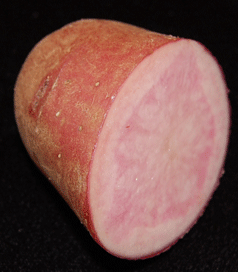
Adirondack Red is a potato variety with red flesh and skin, bred by Cornell University potato breeders Robert Plaisted, Ken Paddock and Walter De Jong, and released in 2004.
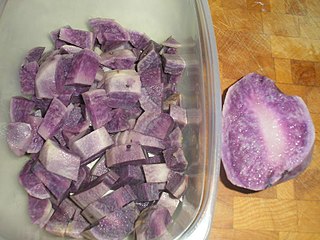
The 'Adirondack Blue' is a potato variety with blue flesh and skin with a slight purple tint, released by Cornell University potato breeders Robert Plaisted, Ken Paddock, and Walter De Jong in 2003.
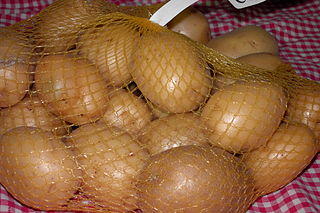
The Agata is a Dutch potato variety. It is a very early maturing, yellow-skinned, yellow-fleshed variety with an attractive bright skin. Agata produces high yields of uniform shaped tubers and is known for its high pack-out. It was bred by Svalöf Weibull A.B., from the cross BM 52-72 X Sirco in Emmeloord in 1976.

Red Norland is a red, early-maturing potato. Smaller tubers are commonly sold as “baby reds” and this variety is often served boiled or in potato salads. The progenitor variety, 'Norland', was released by the North Dakota Agricultural College in 1957. Since the release of 'Norland', other darker red skinned variants were selected, most notably 'Red Norland' and 'Dark Red Norland'. None of these three varieties is under plant variety protection. The darker red strains are now widely grown, and 'Norland' is rarely grown. 'Norland' and its selections are widely adapted, but have relatively low to intermediate yields.
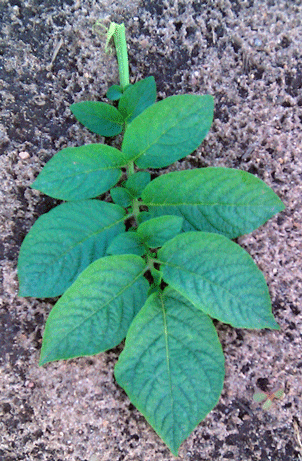
The Atlantic potato is a mid-season potato variety for potato chip manufacturing. It was developed and released by USDA Agricultural Research Service scientists at Beltsville, Maryland, in 1978. The variety is not under plant variety protection. It is a progeny of a cross between 'Wauseon' and 'Lenape'. It is widely grown for chipping directly off the field or with short-term storage. Marketable yields are fairly high.
Alturas is a russet potato variety released in 2002 by the USDA-ARS and the Agricultural Experiment Stations of Idaho, Oregon, and Washington and it is under plant variety protection. It is a processing potato that has cold-sweetening resistance, so it can be processed directly out of storage into French fries and other frozen potato products.
Superior is a white-skinned, white-fleshed, mid-season potato variety. It was released by the University of Wisconsin potato breeding program in 1962, and is not under plant variety protection. It is a progeny of a cross between 'B96-56' and 'M59.44' and was first grown in 1951. 'B96-56' was also a parent of Kennebec. Like the potato variety Atlantic, Superior is widely grown for potato chip manufacturing right off the field and marketable yields are fairly high.
Umatilla Russet is a moderately late maturing variety of potato especially suitable for frozen french fries processing. It was jointly released by the Agricultural Experiment Station of Oregon, Idaho, and Washington and the U.S. Department of Agriculture in 1998. 'Umatilla Russet' has been equal to or better than Russet Burbank in fry color in Oregon and regional trials. The potato was named by the state of Oregon after the Umatilla tribe, from which the city of Umatilla also takes its name.
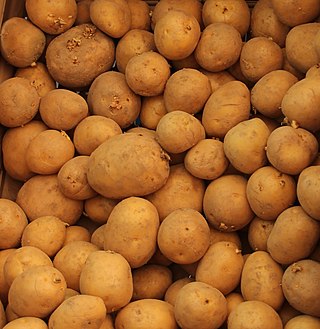
Gala is an early-ripening firm-fleshed edible potato, for which good eating and keeping qualities are claimed. It was developed by the Groß Lüsewitz-based plant breeder Norika. In 2010, it was chosen as Thuringia's potato of the year in a public contest to which nearly 1000 consumers contributed, and in which Laura was second place.
The Villetta Rose is a late maturing red potato variety. It was developed at the University of Wisconsin-Madison and is under plant variety protection. It originated from a cross between Dark Red Norland and Nordonna varieties. 'Villetta Rose' has a medium to long dormancy, stores well and maintains its red color in storage. It is grown for fresh sale and processing including canning.

Melody is a cultivar of potato.
Innovator is potato variety that is oblong in shape with a smooth skin. It is a popular potato variety in Europe and is gaining popularity in North America as a frying and baking potato. The skin of the potato variety is russeted, similar to that of a Russet Burbank potato. Innovator also has shallow eyes with a cream coloured flesh.
References
- 1 2 Red Gold, Canadian Food Inspection Agency, February 7, 2005.
- ↑ Coffin, R.; Johnston, G. R.; McKeown, A.; et al. (February 1988), "Red Gold: A yellow-fleshed, red-skinned potato cultivar with short dormancy and high tuber set", American Potato Journal, 65 (2): 49–55, doi:10.1007/BF02867451.
- ↑ Directorate, Government of Canada, Canadian Food Inspection Agency, Plant Health and Biosecurity (2002-02-14). "Red Gold". www.inspection.gc.ca. Retrieved 2016-12-02.
{{cite web}}: CS1 maint: multiple names: authors list (link) - ↑ Legacy, Herbal. "Hemorrhoids". www.herballegacy.com. Retrieved 2017-04-10.
